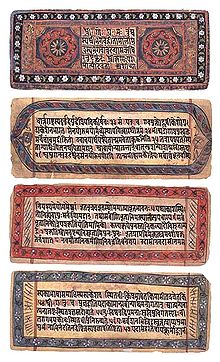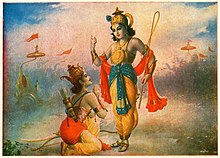Bhagavad Gita
The Bhagavad Gita (Sanskrit, f., भगवद्गीता, gītā - song, poem, bhagavan - the exalted one, God; "the song of the exalted one"), also shortened to just Gita, is one of the central scriptures of Hinduism. It has the form of a spiritual poem. The text, which was probably written between the 5th and 2nd century B.C., is an amalgamation of several different schools of thought from India at that time, based on the older Vedas (Early Vedic writings ca. 1200 B.C. to 900 B.C.), the Upanishads (Late Vedic writings ca. 700 B.C. to 500 B.C.), orthodox Brahmanism (ca. 800 B.C. to 500 B.C.), yoga and others, but is closest in thought to the Upanishads.
The Bhagavad Gita is part of the Mahabharata (Sanskrit, महाभारत, Mahābhārata [mʌhaːˈbʱaːrʌtʌ] "the great story of the Bharatas" in the sense of the epic of the struggle of the Bhāratas), the scripture about the Bharata family (Sanskrit भारत bhārata [ˈbʱɑːɻət̪ə]) and their descendants (Battle of Kurukshetra). In the epic poem of the blind king Dhritarashtra (Sanskrit धृतराष्ट्र, dhṛtarāṣṭra), the seer Saṃjaya describes the struggle for power between the two Bhārata families, the ("good") Pandavas and the ("evil") Kauravas.
The Bhagavad Gita depicts a dialogue between Krishna, an earthly manifestation of Vishnu, the teacher, and Arjuna, the disciple. Vishnu advanced to become one of the main gods of Hinduism, along with Shiva, at the time the work was written. Krishna, the protagonist of the Bhagavad Gita, is considered an avatara (Sanskrit अवतार avatāra, "incarnation, descent, manifestation of God"), the incarnation of the god Vishnu on earth. In the frame story of the Bhagavad Gita, Krishna, as a manifestation of the Divine, presents the basic ideas about life to the young warrior and prince Arjuna on the battlefield. In doing so, he shows him his divine nature and instructs him in rules of conduct for recognizing the divine.
Hindus traditionally regard the teachings of the Bhagavad-Gita as the quintessence of the Vedas. Study often reveals apparent contradictions: while some passages seem to teach dualism - the duality of nature and spirit, of God and man - others teach unity. Because of these different interpretations, the poem is the focus for a wide variety of beliefs.
The Bhagavad Gita was written down as a religious-philosophical doctrinal poem in 18 chapters of 700 verses and incorporated into the national epic Mahabarata around the 2nd century AD. The typical verse form is the shloka verse form which can be recited or better chanted, hence Gita. It belongs to the Smriti (Sanskrit, f., स्मृति, smṛti, "what is remembered"), which are the epics (poetry) Itihasa (Sanskrit: इतिहास itihāsa m.; literally: "thus (Iti) verily (ha) it has been (āsa)"), to which, besides the Mahabharata, the Ramayana is also reckoned.

Krishna giving philosophical instruction (upadesha) to Arjuna in a chariot (ratha) on the mythological battlefield of Kurukshetra. Cement cast sculpture in Tirumala
Formal aspects
The Gita, as it is abbreviated in India, consists of 700 stanzas divided into 18 cantos or chapters. It is part of the Mahabharata, an epic of about 100,000 stanzas, and comprises cantos 25 to 42 of the 6th book.
The greater part of the work consists of two lines of verse which are related to each other. Each line of verse is composed of two rows of eight syllables. Example (1st canto, verse 47):
evam uktvārjunaḥ saṅkhye (eight syllables).
rathopastha upāviśat, (eight syllables).
visṛjya sa śaraṁ cāpaṁ, (eight syllables).
śokasaṁvignamānasaḥ. (eight syllables)
And Arjuna sank
back, sadly filled, on
his chariot seat,
The bow slipped from his hand,
And grief flashed around his gaze.
In some stanzas this meter is deviated from for no apparent reason.
According to the Indologist Helmuth von Glasenapp, the accuracy of expression and the air of the consecrated, which are peculiar to the original text, cannot be fully transferred. Another difficulty in translation is to remain faithful to the original and yet preserve meter and rhyme.

Four manuscripts of the Bhagavad Gita from the 19th century
Krishna, the teacher
It is a self-revelation of Krishna, who, before the beginning of a great war, which the Mahabharata describes in detail, reveals himself as the divine or cosmic self to the prince Arjuna on the battlefield of Kurukshetra.
According to Hindu mythology, we are now living in the Kali Yuga, the "dark, black age" that began after Krishna's death (3102 BC). There is another tradition according to which we are already in the next age, the Dvapara-Yuga. Krishna is said to have come to give to men those ethical and philosophical instructions which are necessary for the time of this Yuga. In Chapter IV, 7-8 Krishna promises to incarnate again and again:
"O son of Bharata, as often as there is a decline of Dharma (righteousness, virtue) and a prevalence of iniquity and vice in the world, I create myself among creatures. Thus, from period to period, I incarnate myself for the preservation of the righteous, the destruction of the wicked, and the upliftment of the Dharma."
Krishna is given different meanings in the Bhagavadgita, depending on the context: on the one hand, he is seen as the cosmic self that pervades all living things; another aspect is the meaning as the inner divinity, which is a reflection of the cosmic self in every living being. A third function is that of spiritual teacher.

Krishna reveals himself to Arjuna
Questions and Answers
Q: What is the Bhagavad Gita?
A: The Bhagavad Gita is one of the holy books of Hinduism that contains teachings given by Lord Sri Krishna.
Q: When was the Bhagavad Gita written?
A: The Bhagavad Gita was written about five thousand years ago as part of the Mahabharata.
Q: Who is Lord Sri Krishna?
A: Lord Sri Krishna is the Supreme God in Hinduism and is said to have given teachings in the Bhagavad Gita.
Q: Who is Krishna talking to in the Bhagavad Gita?
A: Krishna is talking to Arjuna, an Archer, before the kurukshetra war begins.
Q: What does Krishna tell Arjuna to do in the Bhagavad Gita?
A: Krishna tells Arjuna that he must perform his duty (called dharma) and go to fight, even though he is fighting his family.
Q: Why does Arjuna hesitate to fight in the Bhagavad Gita?
A: Arjuna hesitates to fight because he is fighting his family.
Q: What is the Bhagavad Gita considered to be?
A: The Bhagavad Gita is considered to be the manual on which a human should follow his life according to Sanatana Dharma.
Search within the encyclopedia